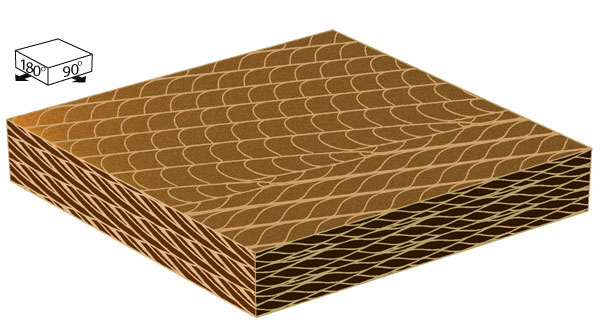Pacific Coastal and Marine Science Center
Bedform Sedimentology Site: “Bedforms and Cross-Bedding in Animation”


FIG. 46K. Structure formed by bedforms with along-crest- migrating superimposed bedforms. The bedforms have a height ratio of 0.15 and a speed ratio of 3.0. The resulting ratio of along-crest to across-crest transport is 0.45; the transport direction is oriented 66 degrees from the crestlines of the main bedforms. Figure 46 series structures formed by straight-crested bedforms with scour pits and straight-crested, migrating, superimposed bedforms or lee-side spurs. Real examples of such bedform assemblages are shown in Figures 47-49; real deposits are shown in Figures 50-54.
RECOGNITION: Because of the wide variety of possible sizes, migration speeds, and migration directions of superimposed bedforms relative to the main bedforms, the structures deposited by such bedform assemblages vary greatly in appearance. All of these structures, however, share several features in common. Except where superimposed bedforms have crestlines that exactly parallel the main bedforms, the troughs of the two sets of bedforms intersect to form topographic depressions that geometrically behave like scour pits. Migration of the main bedforms causes the scour pits to migrate with a crest-transverse component (left to right in the computer images); migration of the superimposed bedforms causes the scour pits to migrate with a crest-parallel component of migration (away from the viewer); and deposition causes the scour pits to migrate upward. The resulting scour-pit paths are oblique to the crestlines of the main bedforms. The depositional structures are recognizable in horizontal sections by the oblique orientation of trough axes (scour-pit paths) relative to the trends of the main bedforms. The oblique orientation of the bedforms relative to the transport direction causes a bilateral asymmetry in the distribution of cross-bed dips and bounding-surface dips and causes an asymmetrical distribution of cross-bed dips relative to bounding surface dips. In horizontal sections, the trend of the main bedforms is indicated by (1) the strike of the relatively continuous foresets deposited where superimposed bedforms did not scour bounding surfaces, either because superimposed bedforms were locally absent or because they climbed at stoss-depositional angles (Figs. 39 and 46D, E, F, and H) and (2) an imaginary line connecting the points at which adjacent scour pits in a bedform trough simultaneously migrated upward through a horizontal section. Note that the main bedform trend does not parallel the bounding surfaces scoured by the superimposed bedforms. The trend of the superimposed bedforms is not directly observable in either horizontal or vertical sections but is defined by the lines of intersection of the bounding surfaces scoured by the superimposed bedforms and the cross-beds deposited by the superimposed bedforms (Rubin and Hunter, 1983). This principle arises from the fact that during migration of a bedform, the bounding surface being scoured and the cross-bed being deposited intersect along the trough line of the bedform. This trough-line trend (which approximately parallels the crestline trend) can be determined by using either of two techniques. The first technique, which has the most general applicability, uses a stereonet to plot the line of intersection of the cross-bed and bounding-surface planes. A second technique can be employed at those outcrops that fortuitously contain exposures in which the cross-bed traces lie parallel to the bounding-surface traces scoured by the superimposed bedforms. When such outcrops can be located, nature (rather than the stereonet) has performed the appropriate geometric manipulations required to locate the intersecting cross-bed and bounding-surface planes; the trend of the line of intersection of the two planes parallels the outcrop surface. That trend can be measured directly from the outcrop (FIG. 52B). Structures deposited by bedforms with superimposed bedforms migrating toward a divergent direction are useful for indicating paleotransport directions. Paleotransport directions can be determined relatively precisely if the relative sizes, migration speeds, and migration directions of the different sets of bedforms are known. Where these parameters are not known, as is usually the situation with ancient deposits, these structures are still useful for indicating the quadrant of the paleotransport direction.
ORIGIN: Bedforms with superimposed bedforms migrating in another direction (and the resulting stratification) are common in eolian flows (Figs. 47A, 51-53, and 74- 76; Rubin and Hunter, 1983; Sweet, 1992; Kocurek et al., 1999; Scherer, 2000; Mountney and Thompson, 2002; Ulicny, 2004), fluvial flows (Fig. 54; Beutner and others, 1967; Boersma and others, 1968), tidal flows (Dalrymple, 1984, Fig. 5D; Fig. 47B; Reynaud et al., 1999), and nearshore marine flows (Fig. 50; Rubin, 1987). A wide selection of these structures is illustrated because the structures are varied in appearance, are common, interpretable, and are useful indicators of paleocurrent directions. Flow conditions that are required to produce these kinds of bedform assemblages are discussed in the section Three-dimensionality caused by superimposed topographic features.